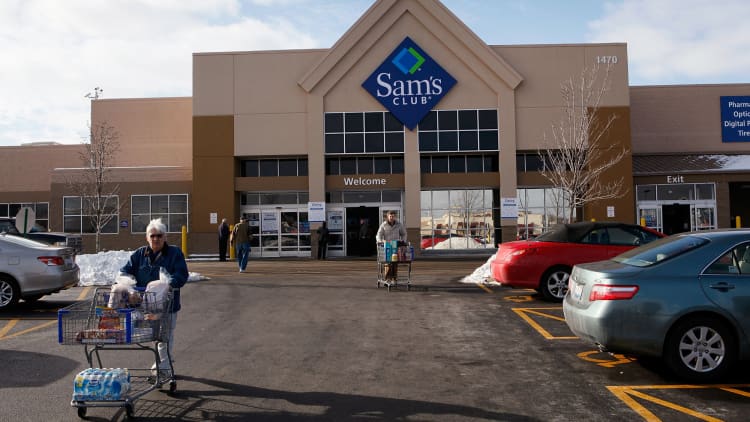More stores could be closing across the U.S. than we ever read about, leaving malls with even bigger gaps to fill.
Out of the roughly 2,500 stores that closed in U.S. malls over the past year, excluding department stores, about 980 weren't publicly announced, according to a new report from Green Street's Advisory Group. That list includes names like Stride Rite, Hallmark, Claire's and Men's Wearhouse, the firm found.
More companies are choosing to silently shutter their doors by letting their leases terminate, thereby escaping any public mess, Jim Sullivan, president of Green Street's Advisory Group, told CNBC.
"Many important national retailers are closing ... where there hasn't been fanfare, and it hasn't been as obvious," Sullivan said. "A lot of the focus has been on anchor-store closings, which is an important part, but some of these other signals are happening under the radar with the in-line tenants, which can be just as important but not as obvious."

These moves are likely to become a bigger trend in 2018, especially in the wake of real estate investment trust Simon Property Group winning a case brought against Starbucks. The coffee giant attempted to close a handful of its Teavana stores, but was blocked. The ruling was a win for real estate developers, but now retailers are prepared to be more subtle as they move out.
Meanwhile, the pressure from these closures makes it easier for the retailers that are still opening new stores across the country, including H&M, Land's End and Finish Line. These companies can be "very selective," unlike how they operated in the past, and are rarely considering moving into anything but a "high-quality" property, Sullivan explained.
More store closures — whether done quietly or publicly — will separate America's best malls from the underperformers this year, based on the analysis by Green Street's Advisory Group.
"In 2018 we'll see a broader distinction between the malls ... who are going to make it, and those who are really going to struggle to make it," Sullivan said.
Already, liquidation sales are in place for the 103 Sears and Kmart stores, and 11 Macy's locations, that will close early this year. Other names like Gap, Children's Place, Mattress Firm and Ascena Retail Group, the owner of Ann Taylor and Loft, are also expected to trim back their store counts in 2018.
The number of stores expected to close both in and out of malls across the U.S. this year totals 1,509, only 12 days into 2018, according to FGRT (formerly Fung Global Retail & Technology). That tally includes the 63 Sam's Club locations that Walmart revealed on Thursday would close as soon as this week.
'Business as usual' for some
Mall operators aren't just replacing retailers with other retailers. Faced with the threat of having a dark box at one of their properties, most developers say they've been lining up a new host of tenants that include upscale restaurants, arcade complexes, bowling alleys, grocers, gyms and even apartment complexes.
To be sure, some retail REITs are in a better position to fund their redevelopment journeys than others.
"The key thing to remember is for the 'A' mall guys in general — they can fund the redevelopments from the free cash flow they have on hand," Boenning & Scattergood analyst Floris van Dijkum told CNBC. "It's business as usual" for names like Simon, General Growth Properties, Macerich and Taubman, he said regarding the latest store closure announcements from Macy's and Sears.
"For the 'B' and 'C' mall guys, it's going to call into question the viability of that property because the returns aren't as high," van Dijkum cautioned. For some mall owners in more rural areas, redevelopment expenses might be too high, and tenants' rents too low to justify such an undertaking, he said.
Across the U.S., more than 300 malls are considered "C" quality, or likely producing less than $300 in sales per square foot, and face the risk of going dark, according to CoStar Group.
"These assets may close or be reinvented into something else," Suzanne Mulvee, a senior real estate strategist at CoStar, told CNBC. "We expect this to be a multi-year process, only accelerated by chains closing large numbers of stores, especially anchors."
It used to be retailers were cheered on by Wall Street for adding more locations, she explained. "Store count and market capitalization were going hand-in-hand right up until the housing bust ... then the ugly truth showed up."
However, Pennsylvania REIT CEO Joe Coradino told CNBC the closing of underperforming department stores is a "win-win." A company like Sears can focus on its better real estate, he said, and PREIT can revamp a portion of its mall to hopefully appeal to more shoppers.
"Where we have added new uses, like entertainment and off-price, we have seen traffic increases and new customers," Coradino said. "We are really excited by all of the new [companies] that have become interested in malls — tenants have become agnostic to center format and are looking at the best locations, which is opening up a new breed of businesses."
Replacements for recently shuttered Sears stores in particular include "eater-tainment" venues, like Dave & Buster's, low-price grocery chain Lidl, and TJX's brands HomeGoods and HomeSense.
"We can take back [space] at that mall and use that as a catalyst to bring in other types of users," Stephen Lebovitz, the CEO of CBL Properties, told CNBC. And in some cases, based on contractual agreements, CBL will be working with Sears in the future to reopen in a pint-sized format, he added. J.C. Penny has also taken on a second life in malls in similar arrangements.
Still, Wall Street isn't convinced all of these projects will be successful.
Shares of CBL have fallen more than 48 percent over the past 12 months. Rival Washington Prime Group's stock has fallen 30 percent over the same period, whereas PREIT's shares are down 36 percent from a year ago.
"A" mall developers including Simon have fared slightly better, especially building on recent M&A chatter (Brookfield making a bid for GGP) and activist activity in the space.
The question many analysts and investors continue to ask is: how costly are these mall redevelopments, and how timely of a process are they?
"[Redevelopment] does cost money, but we have laid out a detailed capital plan where we are selling non-core assets — that we don't want to invest in or don't fit with our strategy — and raising funds in creative ways," Coradino said.
Store closures aside, more bankruptcies are looming and many could hit early this year, according to Credit Suisse Group. The industry's "large and undeniable transformation" could ultimately impair rents and vacancy rates at some retail properties in 2018, strategists Roger Lehman and Benjamin Rozyn wrote in a recent note to clients.
That won't leave mall owners with much time to react, so they better be ready.
WATCH: It's clear the consumer is back



